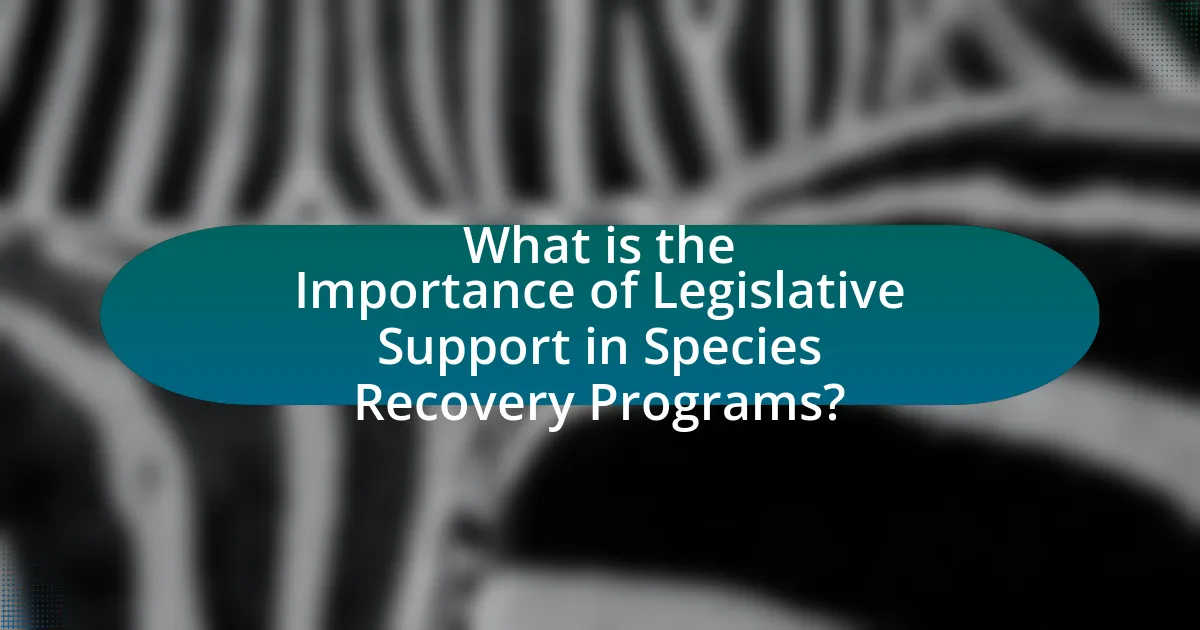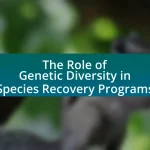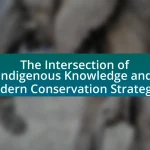Legislative support is essential for the success of species recovery programs, providing the necessary legal framework and funding for effective conservation efforts. Key laws, such as the Endangered Species Act in the United States, empower agencies to protect endangered species and their habitats, facilitating collaboration among various stakeholders. This article explores the critical role of legislation in securing funding, shaping recovery initiatives, and enhancing public awareness, while also addressing the challenges faced in obtaining legislative support. It highlights best practices for advocates and the importance of partnerships in strengthening recovery efforts, ultimately underscoring the impact of legislative measures on biodiversity conservation.

What is the Importance of Legislative Support in Species Recovery Programs?
Legislative support is crucial for species recovery programs as it provides the legal framework and funding necessary for effective conservation efforts. Laws such as the Endangered Species Act in the United States empower agencies to protect threatened species and their habitats, ensuring that recovery plans are implemented and enforced. This legal backing facilitates collaboration among government agencies, non-profit organizations, and local communities, enhancing the overall effectiveness of recovery initiatives. Furthermore, legislative measures often allocate financial resources, enabling research, habitat restoration, and monitoring efforts essential for the success of these programs.
Why is legislative support crucial for species recovery?
Legislative support is crucial for species recovery because it provides the legal framework and resources necessary for effective conservation efforts. Laws such as the Endangered Species Act in the United States have been instrumental in protecting threatened species by enabling habitat preservation, funding for recovery programs, and enforcing regulations against poaching and habitat destruction. For instance, the recovery of the American bald eagle, which was once on the brink of extinction, is largely attributed to legislative measures that restricted pesticide use and protected nesting sites, demonstrating the direct impact of legal support on species survival.
What role do laws and regulations play in species recovery efforts?
Laws and regulations are critical in species recovery efforts as they provide a legal framework for the protection and management of endangered species. These legal instruments, such as the Endangered Species Act in the United States, establish guidelines for habitat conservation, recovery plans, and penalties for violations, thereby ensuring that species at risk receive necessary protections. For instance, the Endangered Species Act has led to the recovery of species like the American bald eagle, which was removed from the endangered species list in 2007 due to successful conservation efforts mandated by this legislation. Such laws not only facilitate funding and resources for recovery programs but also promote collaboration among government agencies, non-profits, and local communities, enhancing the overall effectiveness of conservation strategies.
How does legislative support influence funding for recovery programs?
Legislative support significantly influences funding for recovery programs by establishing legal frameworks and allocating financial resources. When legislators prioritize recovery initiatives, they can secure budget allocations and grants that directly benefit these programs. For instance, the Endangered Species Act in the United States has facilitated millions in funding for species recovery efforts, demonstrating how legislative backing translates into financial support. Additionally, legislative advocacy can mobilize public and private funding sources, enhancing the overall financial landscape for recovery programs.
What are the key components of effective legislative support?
The key components of effective legislative support include clear policy objectives, stakeholder engagement, adequate funding, and robust monitoring and evaluation mechanisms. Clear policy objectives ensure that legislative actions align with specific goals for species recovery, such as habitat protection or species reintroduction. Stakeholder engagement involves collaboration with local communities, conservation organizations, and scientific experts to create comprehensive and inclusive policies. Adequate funding is crucial, as it provides the necessary resources for implementing recovery programs and sustaining long-term efforts. Finally, robust monitoring and evaluation mechanisms allow for assessing the effectiveness of legislative measures and making necessary adjustments based on empirical data, ensuring that species recovery efforts are both adaptive and effective.
How do policies and frameworks shape recovery initiatives?
Policies and frameworks shape recovery initiatives by establishing guidelines, objectives, and funding mechanisms that direct conservation efforts. These structured approaches ensure that recovery initiatives are aligned with legal requirements and scientific best practices, facilitating coordinated actions among stakeholders. For instance, the Endangered Species Act in the United States provides a legal framework that mandates the protection of threatened species and their habitats, thereby influencing recovery strategies and resource allocation. Additionally, frameworks like the Convention on Biological Diversity promote international cooperation and set targets for biodiversity conservation, which further shapes national recovery initiatives.
What types of legislation are most beneficial for species recovery?
Legislation that establishes protected areas, enforces habitat conservation, and regulates hunting and fishing practices is most beneficial for species recovery. Protected area legislation, such as the establishment of national parks and wildlife reserves, directly safeguards critical habitats from development and degradation, allowing ecosystems to thrive. For instance, the Endangered Species Act in the United States has been instrumental in the recovery of species like the American bald eagle and the gray wolf by providing legal protections and recovery plans. Additionally, habitat conservation laws, such as the Marine Mammal Protection Act, help maintain the ecological balance necessary for species survival. Regulations on hunting and fishing, including quotas and seasonal restrictions, prevent overexploitation, ensuring that populations can recover. These legislative measures collectively create a framework that supports biodiversity and promotes the recovery of endangered species.
How does public awareness impact legislative support for species recovery?
Public awareness significantly enhances legislative support for species recovery by mobilizing public opinion and influencing policymakers. When the public is informed about the plight of endangered species, they are more likely to advocate for protective measures, which can lead to increased political pressure on legislators. For instance, studies have shown that campaigns raising awareness about specific species, such as the California condor, have resulted in legislative actions that allocate funding and resources for recovery efforts. This correlation between public awareness and legislative action is evident in the success of the Endangered Species Act, which has been supported by widespread public engagement and advocacy.
What strategies can enhance public engagement in recovery efforts?
Strategies that can enhance public engagement in recovery efforts include fostering community involvement, utilizing social media platforms, and implementing educational programs. Community involvement can be achieved through local workshops and volunteer opportunities, which have been shown to increase public investment in recovery initiatives. Social media platforms serve as effective tools for disseminating information and mobilizing support, as evidenced by campaigns that have successfully raised awareness and funds for conservation projects. Educational programs in schools and community centers can inform the public about the importance of species recovery, leading to greater advocacy and participation, as demonstrated by initiatives that have resulted in increased volunteerism and donations for recovery efforts.
How does public opinion influence legislative action?
Public opinion significantly influences legislative action by shaping the priorities and decisions of lawmakers. When constituents express strong views on specific issues, such as environmental protection or species recovery, legislators often respond by proposing or supporting legislation that aligns with those views. For instance, a 2020 survey by the Pew Research Center found that 66% of Americans believe that protecting the environment should be a top priority for government action, which has led to increased legislative efforts aimed at conservation and recovery programs for endangered species. This correlation between public sentiment and legislative response demonstrates how elected officials are motivated to act in accordance with the preferences of their constituents to secure votes and maintain public support.
What challenges exist in securing legislative support for species recovery?
Securing legislative support for species recovery faces several challenges, including political priorities, funding limitations, and public awareness. Political priorities often shift, leading to reduced focus on environmental issues, as seen in budget allocations that favor economic development over conservation efforts. Funding limitations hinder the implementation of recovery programs, with many initiatives lacking adequate financial backing to achieve their goals. Additionally, public awareness and understanding of species recovery issues can be low, resulting in insufficient grassroots support for legislative action. These factors collectively impede the establishment and maintenance of effective species recovery policies.
What are the common obstacles faced by recovery programs?
Common obstacles faced by recovery programs include insufficient funding, lack of political will, and inadequate public awareness. Insufficient funding limits the resources available for research, habitat restoration, and monitoring efforts, which are crucial for successful recovery. Lack of political will can hinder the implementation of necessary policies and regulations that support recovery initiatives. Additionally, inadequate public awareness can lead to insufficient community support and engagement, which are vital for the success of recovery programs. These challenges are documented in various studies, including the “State of the World’s Birds” report by BirdLife International, which highlights the critical need for comprehensive support to overcome these barriers.
How can these challenges be addressed through advocacy?
Advocacy can address challenges in species recovery programs by mobilizing public support and influencing policy decisions. Effective advocacy campaigns raise awareness about the importance of legislative support, which is crucial for securing funding and resources necessary for recovery efforts. For instance, organizations like the Endangered Species Coalition have successfully lobbied for the protection of various species by highlighting the ecological and economic benefits of biodiversity. Additionally, advocacy efforts can lead to the establishment of stronger legal frameworks that enforce conservation measures, as seen in the implementation of the Endangered Species Act in the United States, which has facilitated the recovery of numerous species.
How can collaboration between stakeholders enhance legislative support?
Collaboration between stakeholders enhances legislative support by fostering a unified approach that amplifies advocacy efforts. When diverse groups, such as government agencies, non-profit organizations, and local communities, work together, they can present a consolidated voice that effectively communicates the importance of specific legislative measures. This collective action can lead to increased public awareness and engagement, which are critical for influencing policymakers. For instance, the collaboration seen in the recovery of the California condor involved multiple stakeholders, including the U.S. Fish and Wildlife Service and various conservation organizations, which resulted in successful legislative initiatives that provided necessary funding and resources for the species’ recovery. Such partnerships not only strengthen the legitimacy of the legislative proposals but also enhance their chances of being enacted.
What roles do NGOs and government agencies play in this collaboration?
NGOs and government agencies play crucial roles in collaboration for species recovery programs by combining resources, expertise, and advocacy efforts. NGOs often engage in on-the-ground conservation activities, raise public awareness, and mobilize community support, while government agencies provide regulatory frameworks, funding, and policy implementation. For instance, the U.S. Fish and Wildlife Service collaborates with NGOs like the Nature Conservancy to enhance habitat protection and restoration efforts, demonstrating how these partnerships can lead to successful recovery outcomes for endangered species.
How can partnerships improve the effectiveness of recovery programs?
Partnerships can significantly enhance the effectiveness of recovery programs by leveraging diverse resources, expertise, and stakeholder engagement. Collaborative efforts among governmental agencies, non-profit organizations, and local communities can lead to more comprehensive strategies that address ecological, social, and economic factors influencing species recovery. For instance, a study by the National Oceanic and Atmospheric Administration (NOAA) found that partnerships in marine species recovery initiatives resulted in a 30% increase in successful restoration outcomes due to shared knowledge and coordinated actions. This demonstrates that partnerships not only pool resources but also foster innovation and adaptability in recovery efforts, ultimately leading to more sustainable and impactful results.
What best practices can be adopted to strengthen legislative support for species recovery?
To strengthen legislative support for species recovery, best practices include fostering collaboration among stakeholders, ensuring robust scientific research informs policy, and enhancing public awareness and engagement. Collaboration among government agencies, non-profit organizations, and local communities can create a unified approach to conservation efforts, as seen in successful initiatives like the Endangered Species Act, which relies on partnerships for implementation. Utilizing scientific research, such as data from the International Union for Conservation of Nature, ensures that policies are evidence-based and effective in addressing the specific needs of endangered species. Additionally, increasing public awareness through educational campaigns can mobilize community support and advocacy, which is crucial for sustaining legislative momentum and funding for recovery programs.
How can successful case studies inform future legislative efforts?
Successful case studies can inform future legislative efforts by providing evidence-based insights into effective strategies and outcomes in species recovery programs. For instance, the recovery of the American bald eagle, which was removed from the endangered species list in 2007, demonstrates how targeted legislation, such as the Bald and Golden Eagle Protection Act, can lead to significant population increases. This case illustrates the importance of regulatory frameworks that support habitat protection and management, which can be replicated in future legislative initiatives. Additionally, data from the recovery of the gray wolf in Yellowstone National Park highlights how successful reintroduction efforts can guide policies that balance ecological restoration with community interests. These examples serve as concrete proof that analyzing successful case studies can lead to informed, effective legislative actions that enhance species recovery efforts.
What are the key takeaways for advocates seeking legislative support?
Advocates seeking legislative support should prioritize building strong relationships with lawmakers and stakeholders. Establishing trust and open communication channels enables advocates to effectively convey the importance of species recovery programs. Additionally, presenting clear, data-driven arguments that highlight the ecological and economic benefits of these programs can significantly enhance their appeal. For instance, studies have shown that investing in species recovery can yield substantial returns, such as increased biodiversity and improved ecosystem services, which are critical for long-term sustainability. Engaging the public through awareness campaigns can also mobilize grassroots support, further influencing legislative action.


